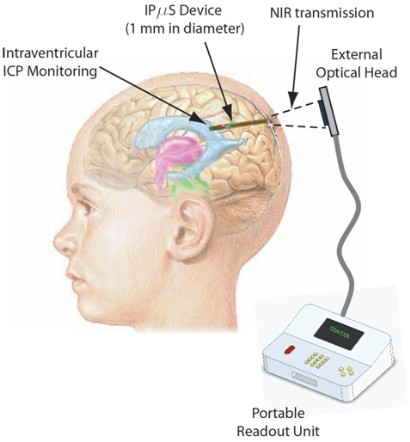Chronis Lab
Implantable Biosensors
Research

Intracranial Pressure (ICP) Monitoring MEMS Sensor
Severe traumatic brain injury (TBI) is responsible for the death and hospitalization of 50,000 and 235,000 Americans respectively every year. Research efforts have identified intracranial pressure (ICP) monitoring as an essential diagnostic tool for the efficient treating of patients with severe TBI. Clinical trials have shown that ICP monitoring following a severe TBI decreases the mortality rate and minimizes secondary injuries. The various ICP monitoring systems have been successful so far in accurately monitoring ICP, but: (a) they have high probability of infection (up to 15%), (b) they do not allow long-term ICP monitoring and (c) they are not MRI compatible.
We are developing an `Intracranial Pressure Micro Stick' (IPmS) technology that overcomes the limitations mentioned above. The technology is based on a fully implantable (cable-free), optical, MEMS device that `color' codes ICP changes: ICP is converted to near infrared (NIR) wavelength. The electronic-free (and thus powerfree) IPmS device enables prolonged ICP monitoring, eliminates the risk of infection, allows patient's comfort and mobility and it is MRI compatible.
The proposed technology will not only help in efficiently managing and treating TBI, but it will inaugurate a new era in the development of implantable, electronic and power-free, miniaturized devices that can be used in a variety of biomedical pressure monitoring applications.
An implantable MEMS sensor can be used to monitor intracranial pressure
Collaborators:
Prof Lynda Yang and Prof Hugh Garton, Department of Neurosurgery - University of Michigan.
Collaborators:
Prof. Shahzad Mian, Kellogg Eye Center - University of Michigan.
IntraOcular Pressure (IOP) Monitoring MEMS sensor
IntraOcular Pressure (IOP) monitoring is an essential diagnostic tool for the efficient treatment of glaucoma and other ocular hypertension-related diseases. Clinical trials have shown that frequent IOP monitoring can decelerate the progress of glaucoma and minimize optical nerve damage
Current IOP monitoring technologies (e.g. tonometry) are non-invasive and simple to execute, but they are not accurate and not suitable for life-long and frequent IOP monitoring: they require a visit to the hospital or to a clinic as the measurement is performed by trained personnel.
We are developing a ‘Near Infrared Fluorescent-based Optomechanical’ (NiFO) IOP sensing technology for accurate, home-based, IOP monitoring for patients with moderate or severe glaucoma. The NiFO technology is based on an electronic-free MicroElectroMechanical Systems (MEMS) implantable sensor (termed the ‘NiFO sensor’) that converts IOP changes into a dual-wavelength optical signal in the near infrared (NI) regime. The NiFO sensor is integrated into an intraocular lens or surgically attached on the iris and therefore permanently implanted into the patient’s eye. An external, portable optical readout system (ORS) is used to excite the NiFO sensor, collect and analyze the emitted NI optical signal. The power-free NiFO sensor permits frequent and life-long IOP monitoring, allows the patient to perform the IOP measurement at home, requires no maintenance (e.g. battery replacement), it is accurate and it has a very small size (< 0.5 mm) and footprint (~0.25 mm).
The proposed technology will help in efficiently managing and treating glaucoma and hypertension-related diseases and it will trigger the development of other implantable, power-free, miniaturized devices that can be used in a variety of pressure monitoring biomedical applications.